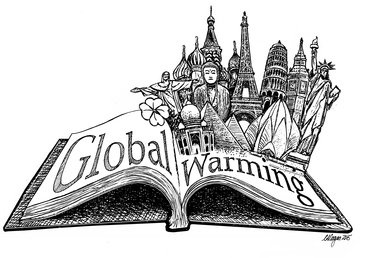All the countries of the world are on the same page at last
New Year’s is a time for resolution — a fresh start. And Janus, the god for which January was named and to whom the Romans made promises, looks both ways, back at the old year and into the new.
We’ve written for New Year’s before about the threat of global warming. Over a decade ago, we were citing scientists to convince our readers it was real and could destroy our Earth if stringent measures weren’t taken — and soon.
The Earth’s carbon emissions have been rising ever since the Industrial Revolution, creating what scientists call the greenhouse effect, trapping heat within the planet’s atmosphere, and shifting the normal climate.
In more recent years, as most Americans have grasped the reality of the threat, we’ve looked at measures individuals could take with the lack of government leadership.
But, for this New Year’s editorial, we have hope because of the accord reached in Paris this month. For the first time, all the nations of the world, 195 strong, participated in the agreement — the rich and developed nations along with the poor and undeveloped nations.
“This moment can be a turning point for the world,” said President Barack Obama in his televised address, announcing the agreement.
We believe it can be. There is now a series of requirements, binding nations by law, to cut emissions, and representatives from all the countries in the world are to meet again in 2020 and every five years thereafter to continue with further plans to cut emissions.
By itself, the Paris accord won’t solve global warming — it will cut greenhouse gases by only half as much as is needed to prevent the increase of 2 degrees Celsius that scientists say would cause devastating and irreversible consequences — severe flooding in some places with equally severe droughts in others, sea levels rising enough to obliterate some island countries as well as devastate many coastal cities, more destructive storms, and food and water shortages in places around the globe.
But the Paris pact is an important shift because it provides a mechanism whereby nations can be held accountable for their part of the pollution.
“We cannot be complacent…The problem’s not solved,” said President Obama.
The hope is that, with the accord in place, investors, heartened by the legal commitment, will produce yet more jobs and products for sustainable energies like wind and solar.
As we look back on 2015, we commend local efforts that helped in preventing climate change. A small group of committed citizens in Knox, which formed years ago with the hope of harnessing wind in the Helderbergs, has now come up with a way that Albany County businesses and residents can buy into a solar farm to meet their energy needs.
Many of the towns and school districts we cover, and even the Guilderland Public Library, have used solar energy to meet some of their needs.
We’ve highlighted on our pages local residents who drive electric cars or who heat without gas or oil. We’ve covered, too, groups that protested pipelines, power lines, and tanker trains of crude oil crossing through our lands, to meet energy needs elsewhere. Some of their protests have yielded safer measures and modifications that will lead to quicker use of sustainable energy.
As the president pointed out, the threat that cutting back on coal and oil use will cost jobs and create havoc is false. Since the federal limits on carbon emissions were put in place, investment in solar and wind power surged with the “largest streak of private-sector job creation in our history,” Obama said.
With the government finally taking a leadership role, individuals still need to do their part.
We Americans are overly dependent on our cars — good planning in our towns and villages, and the laws that enforce this, can cut back on suburban sprawl to build communities where people can walk or bicycle to what they need. We should also make better use of public transportation.
We should shop locally when we can — cutting down on the carbon that comes with transport — and eat more vegetables and less red meat. Unlike fish or chicken, cattle produce a large amount of methane.
When we make choices, like what kind of roof to put on our home, we can pick one that reflects the sun, mimicking the melting solar ice cap. We can insulate our homes and work places so that they are more energy efficient. We can choose a car that uses less gas, or no gas at all.
And, we can be less wasteful. Forty percent of food in America is wasted, thrown out. This not only fills landfills, creating methane, but adds to global warming from having to raise food more than needed.
We can recycle beyond what is required in our towns. We can compost our garbage, creating rich soil, and we can shop for old goods, often better built than new, saving the cost of production.
We have the chance to literally save the world. How’s that for a New Year’s resolution?
— Melissa Hale-Spencer


